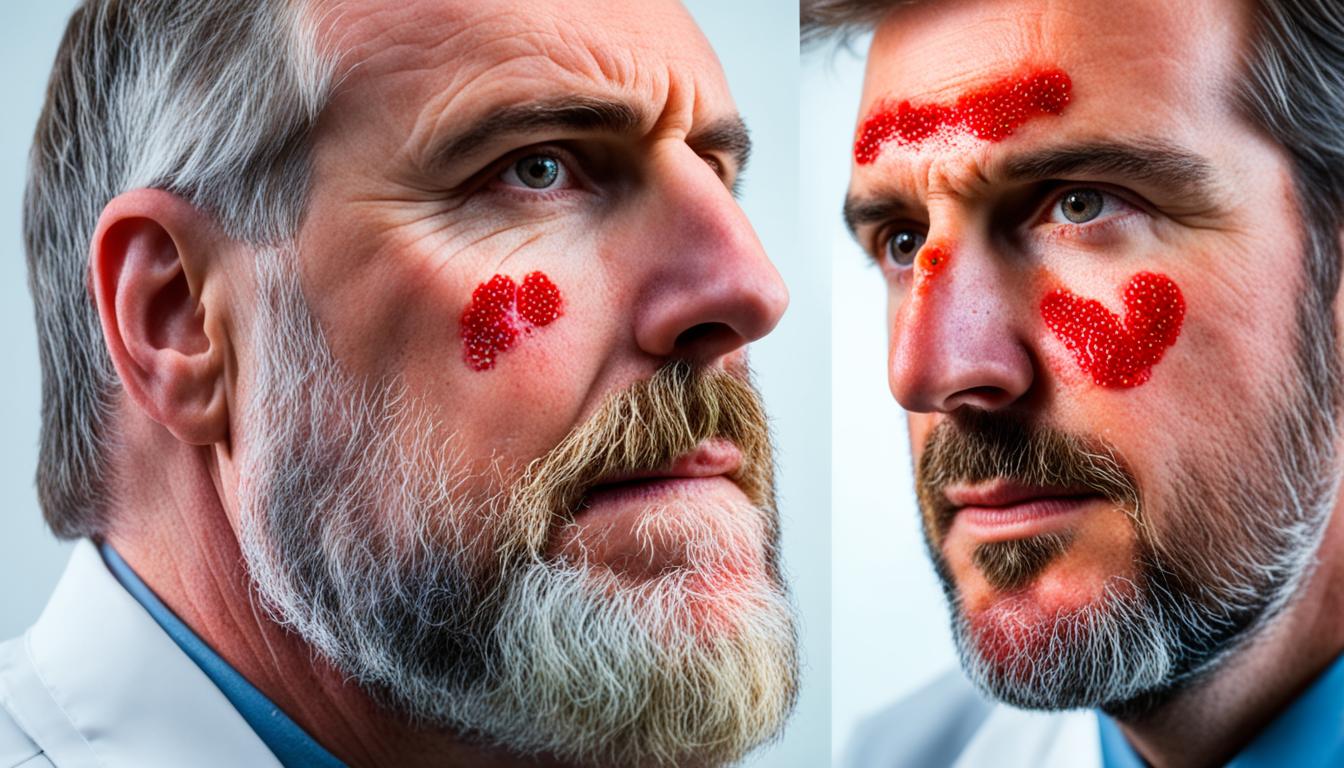Tinea barbae, also known as facial ringworm or beard ringworm, is a fungal infection. It affects the facial hair and skin around it. It’s caused by fungi called dermatophytes. These fungi can get into the hair follicles and the skin. This leads to red, swollen, and bumpy patches in the beard area. It also causes itching, pain, and a rash-like look.
This infection is more common in men. It’s often seen in those who work closely with animals or can pick it up from soil. The main culprits are Microsporum, Trichophyton, and Epidermophyton species of fungi.
Doctors usually diagnose tinea barbae by its symptoms. They confirm it with tests on skin samples. Treatments include antifungal medications and creams, along with oral therapy. Lately, stem cell therapy has offered hope for a new way to treat it. However, more studies are necessary to be sure about its effectiveness and safety.
Key Takeaways:
- Tinea barbae is a fungal infection that affects the facial hair and surrounding skin.
- It is caused by dermatophytes, which are fungi that invade the hair follicles and outer layer of the skin.
- Tinea barbae presents as red, swollen, and bumpy patches in the beard area, causing itching, pain, and a rash-like appearance.
- Diagnosis is based on clinical presentation and confirmed with microscopic examination and culture of skin samples.
- Treatment options include antifungal medications, topical creams, oral therapy, and stem cell therapy.
Causes and Risk Factors of Tinea barbae
Tinea barbae is a fungal infection that affects facial hair and the skin nearby. It’s caused by several things. Knowing these can help prevent and treat it.
Causes of Tinea barbae
This infection comes from fungus called dermatophytes. They like warm, damp places. You can get it from touching an infected person or animal. Sharing things like towels, razors, or clothes can spread it too.
Jobs that get you close to animals, like farming, can raise your risk. This is because the fungus can jump from animals to humans.
Risk Factors of Tinea barbae
Not washing often or not taking care of your facial hair can make you more likely to get Tinea barbae. Good hygiene, including face washing and hair care, is key to prevent it.
Being a heavy sweater can also be a risk. If you sweat a lot, especially on your face, keeping it clean and dry is important.
Having skin conditions like eczema or psoriasis can make fungal infections more likely. It’s important to treat these to lower your risk of Tinea barbae.
People with weak immune systems, like those with HIV/AIDS, are more at risk. They should be extra careful. If they show any signs of infection, they should see a doctor right away.
In the diagram above, you can see the causes and risks of Tinea barbae. Understanding these can help you take steps to prevent it and get the right treatment. Next, we’ll look at the symptoms and how doctors diagnose Tinea barbae.
Symptoms and Diagnosis of Tinea barbae
Tinea barbae is known as beard ringworm or facial ringworm. It shows various symptoms indicating an infection. Symptoms’ severity varies from person to person. The common signs are redness, swelling, itching, and pain in the beard area, along with pus-filled bumps and brittle hair.
It’s crucial to get medical help if you notice these symptoms. To diagnose tinea barbae, a mix of methods is used:
- The first step is a clinical exam. A healthcare professional will look at the skin and hair around the beard to note any infections signs.
- Next, they might take a skin scraping and check it under a microscope. This helps in finding fungal elements like hyphae or spores, confirming the diagnosis.
- Sometimes, a skin sample culture is needed to identify the exact fungus causing the issue. Knowing the type can help choose the right treatment.
Getting the right diagnosis is key to effective treatment for this condition. It’s best to see a healthcare professional skilled in diagnosing and treating skin fungal infections.
Treatment and Management of Tinea barbae
Doctors treat Tinea barbae with antifungal medications. These can be put on the skin or taken by mouth. For not so serious cases, you might get a cream like miconazole. Or an ointment like terbinafine. Apply them right on the itchy area. These medicines kill the fungus and make you feel better.
If the problem is worse or won’t go away, you might need to swallow a pill. Doctors often recommend fluconazole or itraconazole for this. These pills travel in your blood to fight off the fungus all over your body. You might need them if creams don’t work or if the fungus has spread a lot.
It’s very important to stay clean while you are being treated. This makes sure the fungus doesn’t spread. Always keep the area dry. And don’t share things like towels or razors. They could have the fungus on them. This helps to stop the fungus from spreading to others.
Recently, some experts think stem cells might help with Tinea barbae. Stem cells can repair damaged skin and change how the body fights the infection. But we still need to learn more about how safe and helpful this kind of treatment is. More work must be done before it can be used widely.

